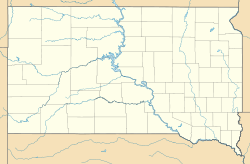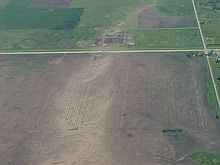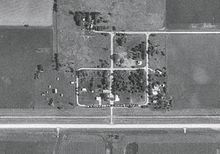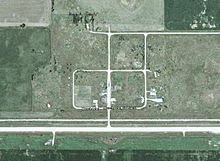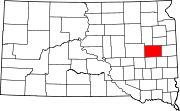- Manchester, South Dakota
-
Manchester, South Dakota — Township — Location within the state of South Dakota Coordinates: 44°22′46″N 97°42′10″W / 44.37944°N 97.70278°W Country United States State South Dakota County Kingsbury Area – Total 55.7 sq mi (144.4 km2) – Land 55.7 sq mi (144.4 km2) – Water 0.0 sq mi (0.0 km2) Elevation 1,608 ft (490 m) Population (2000) – Total 109 – Density 2.0/sq mi (0.8/km2) Time zone Central (CST) (UTC-6) – Summer (DST) CDT (UTC-5) ZIP code 57353 Area code(s) 605 FIPS code 46-40500[1] GNIS feature ID 1268540[2] Manchester was a small unincorporated community in Kingsbury County in the east-central part of the U.S. state of South Dakota. On June 24, 2003, the town was completely annihilated by a large F4-rated tornado, and has since become a ghost town.
Contents
History
Like many South Dakota towns of the era,[citation needed] Manchester was a planned community founded primarily to serve as a stop on the Chicago and North Western Railway,[citation needed] which was the primary line carrying grain east through South Dakota and supplies and settlers west.[citation needed] Manchester was established with the opening of the Manchester post office on June 29, 1881 and named after the town's first postmaster, C. H. Manchester. With the influence of the railroad, Manchester underwent rapid expansion, including the building of "numerous homes, a town hall, grocery stores, livery barns, a lumber yard, two grain elevators, a depot, a restaurant, a cream station, a bank, a pool hall, auto repair, blacksmith shops, gas stations, two churches, a system of township schools including Manchester High School, a hotel, a newspaper and a fabled town pump"[3].
Grace Ingalls Dow, sister of Little House on the Prairie author Laura Ingalls Wilder, spent a significant part of her adult life in Manchester. She worked as a teacher in the local school and died in 1941. Her sister Mary Ingalls lived with her for a while as well. Laura Ingalls Wilder spent many years (and set several of her Little House books) in De Smet, a similarly sized town seven miles to Manchester's east along the railroad line.
Into the 1900s, the diminishing importance of the CNW line through Manchester slowed train traffic and cut into the town's expansion, causing many to leave the town. This slide continued into the Great Depression as the line lay idle and more residents were forced to close their businesses and move elsewhere to find work. Despite road contact finally being made through Manchester in the late 1930s, little remained to induce people to linger and the few remaining residents began to die off or move away, with many relocating to nearby De Smet or Huron. Having lost many of its residents and its primary means of attracting more, Manchester's population steadily dwindled until a core population of no more than 100 residents remained, with most operating farms and ranches outside the town limits. The CNW railroad officially announced its permanent abandonment of the railroad line in 1986 and stopped maintaining the tracks. By 2003, less than a dozen structures (including two operating businesses) remained standing on the original Manchester town plot along US-14 and 425th Avenue.
The Manchester Tornado
Main article: 2003 South Dakota tornado outbreakOn June 24, 2003 a classic supercell thunderstorm spawned a tornado over eastern South Dakota. The tornado gradually matured and widened, forming a large "wedge" shape, and achieving an intensity of F4 on the Fujita scale and a width of between one-half and one mile as it entered Manchester.
The mesocyclone associated with the tornado was tracked by a large number of meteorologists and storm chasers. A small probe was placed directly in the tornado's damage path. The vortex traveled directly over the instrument, and record-breaking meteorological data was obtained by the probe. It managed to survive winds at the time estimated to be up to 260 mph (418 km/h)[4] and measured a barometric pressure fall of around 100 millibars near the center of the half-mile wide tornado. Current estimates of wind speeds in an EF4-rated tornado would be in the 166-200 mph (267–322 km/h) range.
Manchester was an extremely small and compact town, with the central township abutting the intersection of US Highway 14 and 425th Avenue in rural Kingsbury County and surrounded on all sides by miles of farmland. The tornado struck the town from the north while doing strong F3/weak F4 damage, and was easily powerful enough to destroy the handful of elderly structures remaining in the town center (including the town post office), as well as several outlying buildings along US-14. According to Dan Kight of the Kingsbury County Sherrif's department: "There's a business that's partially left, but everything else is gone," noting only three or four families live in Manchester. Also according to Kight, some residents were transported to the hospital with injuries.[5]
Final status
As of 2010, the Manchester town site lies barren and abandoned. All that remains of Manchester is the slab foundations of demolished houses along the dirt road grid that composed the town center and the famous Manchester town pump (which survived a direct hit from the tornado mostly intact). The lush trees which were planted in the 1800s to shelter the town's homes and residents from the summer heat were all razed by the tornado, returning the area to a sea of empty farmland. There are no plans to rebuild, and the destruction of the town's post office and all remaining structures (along with the flight of the few remaining residents) served to finally extinguish Manchester's raison d'être, making it a natural disaster-induced ghost town.
Although the town itself is empty and depopulated, many former official residents of Manchester continue to reside in the unincorporated farm areas between De Smet and Iroquois, South Dakota, and many others have relocated to other small communities nearby. The town has also not been officially "wiped off the map" yet, as it remains on both the government rolls and maps pending the next Federal census.
On June 25, 2007 a granite monument was erected in the ghost town commemorating its history and honoring the residents who had lived there. [6]
References
- ^ "American FactFinder". United States Census Bureau. http://factfinder.census.gov. Retrieved 2008-01-31.
- ^ "US Board on Geographic Names". United States Geological Survey. 2007-10-25. http://geonames.usgs.gov. Retrieved 2008-01-31.
- ^ http://www.waymarking.com/waymarks/WM1X4P_Manchester_South_Dakota
- ^ NOAA National Weather Service, Sioux Falls, SD "Record Pressure Drop Recorded with Manchester Tornado", Retrieved on 2009-10-13.
- ^ "Tornado Pummels Small Minnesota Town". CNN.com. June 25, 2003. http://www.cnn.com/2003/WEATHER/06/25/minnesota.tornado/index.html. Retrieved 2007-05-07.
- ^ Kasa, Roger (2007-06-25). "Monument dedicated in former town of Manchester". Huron Plainsman. http://www.plainsman.com/fe_view_article.php?story_id=1391&page_id=72&heading=0. Retrieved 2007-06-26.
External links
Municipalities and communities of Kingsbury County, South Dakota Cities Arlington‡ | De Smet | Iroquois‡ | Lake Preston | Oldham
Towns Ghost town Manchester
Footnotes ‡This populated place also has portions in an adjacent county or counties
Coordinates: 44°22′09″N 97°43′14″W / 44.36917°N 97.72056°W
Categories:- Geography of Kingsbury County, South Dakota
- Ghost towns in South Dakota
Wikimedia Foundation. 2010.

